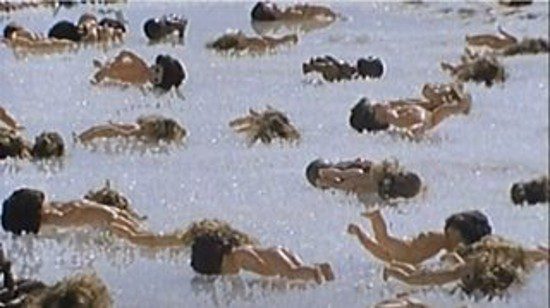Two recent posts over at the Anxious Bench are intimately, if accidentally, connected.
The first of these is by Philip Jenkins, whose wide-ranging curiosity leads him in fascinating directions. He’s been retracing his steps, reviewing some of the disparate topics he has researched, studied, and published on throughout his career and the sometimes surprising connections among them. Jenkins’ latest post in this personal history — “To What Green Altar?” — covers his work researching the Satanic Panic of the 1980s and ’90s.

Jenkins was an early opponent of this panic. “Skeptic” seems too subdued a word for those who, like him, simply refused to accept outrageously impossible stories presented without any evidence to support them. He doesn’t seem to see his opposition to this mass hysteria as anything praiseworthy. Not credulously swallowing ridiculous, absurd, obviously false claims is, in his opinion, nothing to brag about.
The wry tone of his writing looking back on that tumultuous time is captured well in this paragraph:
There is a nice potted history of this whole affair in the recent obituary of Dr. Bennett Braun, a principal actor in the saga. As the New York Times noted, “He diagnosed dozens of patients with what he said were suppressed memories of being tortured by cults. He later lost his license.” Among many striking sentences in the story, I do like this one, from one of his patients: “I began to add a few things up and realized there was no way I could come from a little town in Iowa, be eating 2,000 people a year, and nobody said anything about it.” Well, yeah. Minnesota maybe, but not Iowa.
Jenkins traces how his interest in publishing against the Satanic Panic led to his studies of the folklore and popular culture that shaped the fantasies of the fantasists spreading its lies. This led to further studies into folk horror, cult scares, and “the whole mythology of cults and human sacrifice in American history.” All of which makes Jenkins a reliable source on the source material of the Satanic Panic.
But tracing where all this stuff was gleaned from doesn’t tell us why. Why was it that, in the early 1980s, millions of Americans suddenly wanted to believe that massive numbers of their neighbors were Satanic baby-killers? Why did they want and need to believe this so fiercely that they were defensively furious with those like Jenkins who debunked the obvious lies and impossibilities of this mass delusion?
Saying that the Satanic Panic started with the McMartin preschool trial in 1983 is like saying that World War I started with the assassination of Franz Ferdinand. It may be true, but it still requires a great deal of explanation and a deeper exploration of the context in which such a small spark could create such a massive conflagration.
The McMartin trial did not occur in a vacuum. The rumor that millions of Americans were killing babies in some kind of Satanic ritual started years before 1983. By that year, it was already a standard part of the president’s speeches and of Sunday sermons all across America. The Satanic Panic was simply a pop-culture expression of the abortion panic, which was stirred up in the late 1970s and was based on exactly the same outrageous, obviously false, ludicrous premise that millions of our otherwise normal-seeming neighbors were murdering babies because they were in thrall to Satan.
The Satanic Panic, in other words, was simply a different cultural expression of the same outrageous lie. Grifters like Bennett Braun and Mike Warnke and the creepy doctor/patient-wife duo who invented Michelle Remembers did not invent that lie. They simply noticed that millions of Americans were eager for new versions of that lie. White Americans loved this story. They enjoyed the fantasy because it told them they were better than their neighbors. If those neighbors were out there killing babies — sweet, innocent babies — simply because they were evil, baby-killing, Satan-followers, then of course we must be better than them!
Sure, maybe we didn’t cover ourselves in glory when we opposed every step of the Civil Rights Movement until there was no face-saving option other than begrudging acceptance, and maybe having our longstanding complicity in injustice and our morally obtuse intransigence exposed by that still stings a little, but we can, at least, rest assured that we are better than the Satanic baby-killers, who are somehow most people, so please tell us more about their covens and their blood-drinking cannibalistic orgies. And this paragraph is not about the Satanic Panic, it’s about why and how the same white Christians who opposed the Civil Rights Movement turned into “pro-lifers.”
Thus the connection between Jenkins’ post and the one next to it over at the Anxious Bench. “Sheep in Wolves’ Clothing: A parable and a provocation” is from Wyatt Reynolds and it’s mostly about how the historian Mark Noll is a mensch.
More specifically, it’s about how Noll set an example for younger historians by maintaining a fierce, principled commitment to pursuing the truth while also extending enormous generosity, patience, and grace to a host of younger historians, including Reynolds himself. He also shows how Noll modeled that generosity even when dealing with his most willfully obstinate critics.
And so Reynolds offers a long look at one extreme example of Noll’s patient, charitable engagement with one such exceptionally willful and obstinate critic: Francis Schaeffer. Because he is trying to extoll, and thus to imitate, Noll’s example, Reynolds is tactful and delicate in his description of Schaeffer’s attacks on the historian. But the portrait Schaeffer’s own words and actions paint is clear enough on its own: Francis Schaeffer was a weird man who wanted to be a slightly smarter David Barton, and he wasn’t going to let inconvenient facts or truth get in the way of his quest for power. He was furious with Noll and other academic historians for not bending their work in support of his political agenda, which was, very much an agenda of supporting the Republican party while pushing it to be ever more like the theocratic Neo-Confederate vision of Rousas Rushdoony.
When Schaeffer first started sending angry book-length letters to Noll he hadn’t yet settled on abortion politics as the shorthand proxy for his theo-mythic vision for America. Before blaming all of America’s ills on the sinful disobedience of Satanic baby-killing, he tried out a host of other candidates, but none of them got much traction. They lacked the superlative self-flattery he would eventually find in standing on the shore of the Dead Sea surrounded buy hundreds of plastic baby dolls to demonstrate that he was better than those baby-killing monsters who rejected his moral and political authority.
It’s impressive that Noll kept his temper in his dealings with Schaeffer’s nuttery, particularly since Schaeffer had a combination of incomprehension mixed with condescension that tends to be especially exasperating. But I wonder if such affable patience didn’t do Schaeffer himself a disservice. I mean, jeez, lots of people have misunderstood Kierkegaard, but most of them don’t go on to base their whole career and personality on that.
What Francis Schaeffer desperately needed in his life is somebody who could stand up to him and correct him like Jamie Lee Curtis in A Fish Called Wanda, deflating his misplaced pride in his intellect by saying, “Apes do read philosophy, Francis. They just don’t understand it. Now let me correct you on a couple of things, OK? Aristotle was not Belgian. The central message of Buddhism is not ‘Every man for himself.’ And the London Underground is not a political movement. Those are all mistakes, Francis. I looked them up.”
It’s also a mistake to think of the simultaneous rise of white Republican abortion politics and the Satanic Panic as two separate phenomena. They’re the same thing, based on the same lie about our neighbors — the same desire to believe the lie that millions of those neighbors are killing babies because they are in thrall to Satan. You cannot understand either side of this single thing without understanding the self-flattery that drives the appeal of that lie.













